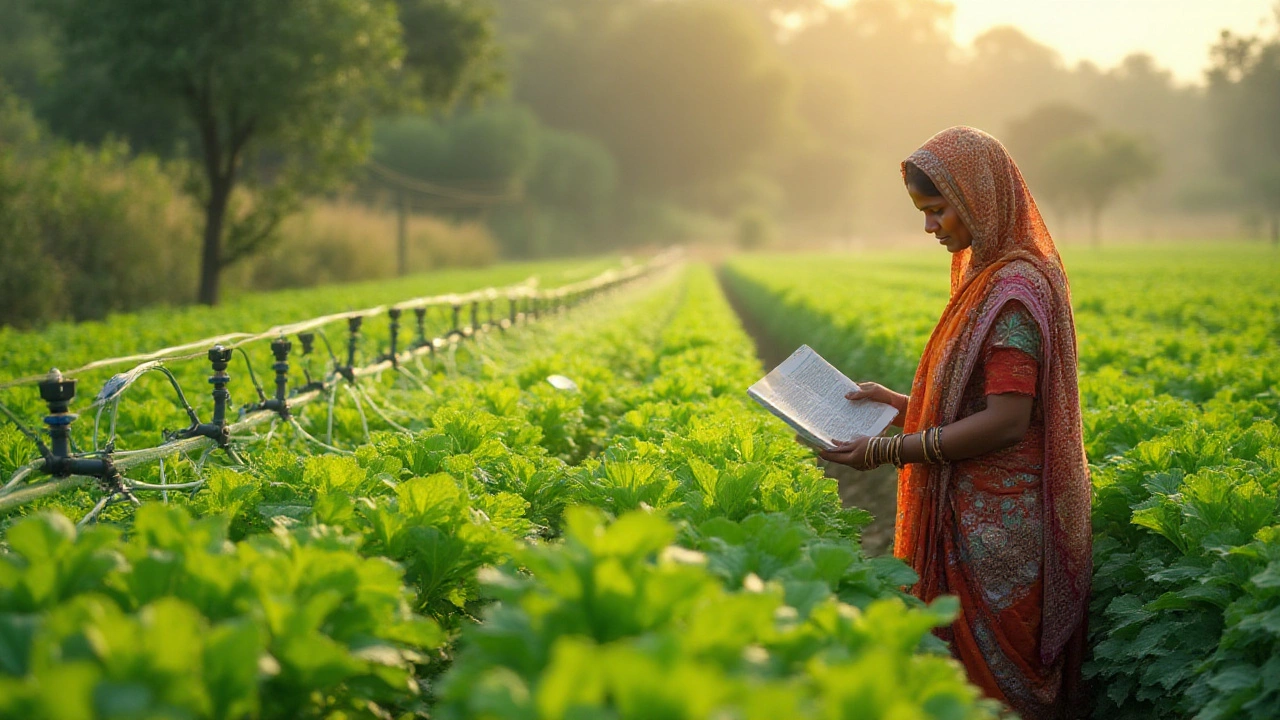Picture this: you stroll past a neighbor's spotless rows of tomatoes and peppers, each plant dotted with glossy leaves and juicy fruit. At their feet, skinny black pipes snake between the stems, quietly doing the work of watering drop by drop. It looks so clean and must save tons of water—but then you check the price of installing your own drip irrigation, and bam. Sticker shock. If you've ever come close to buying a drip setup, you know it doesn't come cheap. People rave about how it saves water and boosts yields, but the numbers on the quote sheet make you pause. Where's all that cash going? Why is something that seems so simple—just some tubes and drippers—so annoyingly pricey? Grab a coffee, because it's time to break down why drip irrigation hits the wallet hard, and what you can actually do about it.
The Real Cost Behind Drip Irrigation
When you see a drip irrigation kit online for £80 or a big garden install pushing four figures, it's tempting to think this is just greedy upselling. Not quite. Let’s pull back the curtain. Most of the cost comes from the actual hardware, especially if you want something that lasts through more than one rainy Manchester summer. The tubing might look simple, but it's made from UV-resistant, flexible materials—often polyethylene built to handle years of sun and pounding rain. Then there’s the emitters and drippers, which have to be engineered so they never clog. Cheap ones will just flood your prize roses or clog with limescale and algae in no time.
Add in pressure regulators, water filters, timers, backflow preventers—all these bits keep the water flowing steady and clean. Professional-grade kits offer lots of options and flexibility, but those come at a premium. And if your garden has any slopes, changes in plant heights, or different watering zones? That means more valves and custom fittings. The more tailored and flexible your system, the higher the cost creeps. No two gardens are quite the same, and mass-produced 'one size fits all' drip kits often don’t deliver results.
Installation also piles on. If you’re the handy type and don’t mind dirty nails, you can save here. But if not, the cost of professional labor in the UK starts at around £25 per hour (sometimes more if you live closer to London than Manchester). Surveying your garden, laying pipe, drilling into masonry, and setting up control boxes take skill if you want an even water spread. Experienced fitters will often need to work around obstacles underground—tree roots, buried stone, or leftover rubble from old construction. Sometimes, you have to add new hose bibs or even tweak your plumbing. Those extras add up fast.
Another sneaky expense? Water meters, controllers, and smart sensors that let you run your system from a phone or link to rain forecasts. These smart upgrades are popular because they can slash water bills or avoid manual checks. But a quality controller alone can cost more than an entry-level smartphone. There’s a reason why pros recommend budgeting as much for digital add-ons as for tubing and emitters. That all adds to the final tally at checkout, making that initial investment downright intimidating.
Breaking Down the Main Factors for High Prices
The price tag for drip irrigation doesn’t boil down to a single culprit. Let’s break out what actually tips the numbers up. First, material quality is king. If you use the cheapest tubing, sunlight and frost can turn it brittle in a single winter. Investing in industrial-grade pipes, sturdier fittings, and clog-proof emitters matters if you want a system that works year after year, instead of constantly fixing leaks. According to a 2022 survey from the Horticultural Trades Association, well-made systems last about 7-10 years with basic maintenance—so even though you’re paying more upfront, you save on repairs or replacements.
Now add in how garden layout drives costs. Simple, flat beds are much cheaper and easier to kit out than sloped, oddly shaped patches. If you want to water hanging baskets, raised beds, or a row of distant fruit trees, you’ll need extra tubing, connectors, and often booster pumps. The layout, length, and number of watering zones tie directly to your budget. Some Manchester gardeners I know saw their bills double just to irrigate two extra beds on the other side of a shed.
Labor is another big one. DIYers cut costs, but not everyone wants to spend their Saturdays measuring pipe and deciphering cryptic instruction manuals. Hiring a pro speeds things up and nearly guarantees fewer leaks, but it’s not cheap. You’re paying for experience, proper design, and warranty coverage against future hiccups. Plus, licensed installers can sometimes source gear at trade-friendlier rates, though not always enough to offset their hours.
Then there’s tech. Simple manual timer? Less expensive, but you need to remember to reset it every time you change your schedule. Automatic systems with moisture sensors, rain shutoff controls, and Wi-Fi all push up the tab. These aren’t just gadgets—they make the system smarter, saving water. But, be realistic: the more automatic the system, the steeper the price. Remember that part of your investment is about future-proofing—if the weather in Manchester gets even wetter or drier in coming years, a smart controller makes dialing in efficiency much simpler.
Don’t ignore hidden costs, either. For instance, adding a backflow preventer is mandatory in many UK regions to avoid drawing fertilizers into the house water. This bit of safety hardware costs extra but is a legal requirement. Spare parts, repairs, occasional actuator replacements, and blockage cleanup should go in your budget as ongoing costs, not one-offs.

Are The Benefits Worth the Investment?
It’s easy to get hung up on how much you pay upfront, but drip irrigation has clear upsides. Water prices in the UK have crept up steadily; my water bill in Manchester has climbed by 15% over the last three years. Drip systems use up to 70% less water than sprinklers, according to an RHS study in 2023, mainly because the water goes straight to the roots instead of evaporating in the air. That means lower bills, huge for big gardens or during hosepipe bans.
Crops and flowers tend to love the consistency. Traditional watering can soak the surface and then leave roots dry for too long. Drip irrigation delivers small, steady amounts—just what sensitive plants like tomatoes or strawberries need to avoid splitting or mildew. I’ve seen my own beans get fewer fungal diseases since switching from overhead watering. Over a whole season, you can easily get 20-30% bigger harvests. For commercial operations or keen kitchen gardeners, that extra yield pays back the investment pretty quickly.
It’s not just about water, either. Drip systems slash weeding because you’re not splashing every bare bit of soil. Less runoff means fewer pollutants ending up in rain drains, which is big for cities like Manchester aiming to cut garden pollution. Plus, you get time back—no more lugging hoses or guessing if the far corner of the bed got enough to drink. If you value your Saturday mornings and want your plants to survive summer holidays, the savings in time and worry really do start to justify the cost.
One thing I'm always reminding friends: a well-designed system usually lasts a decade. You pay more at first, but amortize that over time, and the monthly cost looks a lot less terrifying. For some, especially anyone growing rare or valuable plants, the protection against drought or even vandalism (automated controls can keep watering discreet) is worth the spend. Water savings build up steadily and the eco-cred alone might win you some brownie points with your council or green-thumbed spouse—honestly, my wife Elara won’t let me forget the first summer our roses didn’t wilt once.
How to Cut Costs and Get the Most from Drip Irrigation
If all this still sounds like a mountain to climb, don’t lose hope. There are clever ways to make drip irrigation work on a budget. First, go modular. Start with the beds or zones that need water most—maybe your tomatoes and greenhouse pots. Leave less thirsty ornamentals for a future upgrade. Most good drip systems let you bolt on extra lines bit by bit; you don’t have to blow hundreds of pounds upfront.
Shop local or look for group-buy options. Manchester garden centers often stock basic kits, and during spring, you can sometimes catch bulk deals by teaming up with neighbors. Second-hand kits pop up online—just double-check for wear, missing fittings, or brittle pipes. Sometimes getting tubing in longer rolls (50m or 100m) is cheaper per metre, even if you have to store spares.
If you’re handy, DIY can save a chunk. Plenty of YouTube channels break down layout, installation, and even fixing leaks. Borrow a pipe cutter or stakes from a friend. When in doubt, keep receipts so you can swap odd connectors or joiners that don’t match. Testing systems before covering pipes is also key: run water through, check for leaks, adjust emitters, and watch for puddles where flow rates are too high. Preventing mistakes early beats digging up your beds later.
Maintenance is another money-saver. Clean filters every month, especially after heavy rain (Manchester gets plenty). Flush lines at the end of each season, and store removable parts inside if frost is a risk. If you spot algae or mineral build-up in emitters, soak them in vinegar for a night—an old trick that I learned from my own dad, a greenhouse obsessive. Little bits of attention keep costly repairs at bay.
Look for rebates or grants. Some local councils, especially in areas pressing for water conservation, offer subsidies for efficient irrigation installs. Ask at your garden centre or look up council web pages in spring. It's not a guarantee, but it's surprising how often funding for water-saving tech goes unclaimed.
Finally, remember to measure twice, cut once. Layout your beds, measure distances, and buy the right connectors and tubing, not the flashiest. Don’t spring for app-enabled controllers if you’ll never use them—start basic, see what fits, and only upgrade later if your habits match the tech.
The upfront tag on drip irrigation is high, but when you break down the costs, it's all about long-term value. Smarter material choices, a phased approach, and maybe some old-fashioned neighborly teamwork can make this high-tech watering dream a real option for any backyard grower. When your plants stay green during the next dry spell and your water bill stops creeping up, that investment starts to feel less like a splurge and more like a downright smart decision.

